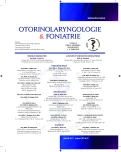Facial (Craniofacial) Epitheses
Authors:
J. Boleslavská 1; Petr Matoušek 1
; J. Rosický 2; Pavel Komínek 1
; M. Paciorek 2,3; R. Lipina 4
Authors‘ workplace:
ORL klinika FN Ostrava
1; Ortopedická protetika Frýdek-Místek
2; Klinika plastické chirurgie FN Ostrava
3; Neurochirurgická klinika FN Ostrava
4
Published in:
Otorinolaryngol Foniatr, 63, 2014, No. 3, pp. 193-197.
Category:
Case Reports
Overview
The authors present their experience of the application of silicon epitheses in patients after mutilating surgical interventions in the head region. Advantages and disadvantages of silicon substitutions, indications and perioperative management are discussed. Cases of patients, where epitheses were used to cover defects and reconstruction after radical oncological surgeries are described.
Keywords:
silicon epitheses, mutilating interventions
Sources
1. Ahmed, B., Butt, A. M., Hussain, M., Amin, M., Yazdanie, N.: Rehabilitation of nose using silicone based maxillofacial prosthesis. J. Coll. Physicians Surg. Pak., 20, 2010, s. 65-67.
2. Bilhan, H., Geckili, O., Bural, C., Sonmez, E., Guven, E.: Prosthetic rehabilitation of a patient after surgical reconstruction of the maxilla: a clinical report. J. Prosthodont., 20, 2011, s. 74-78.
3. Goiato, M. C., Anchieta, R. B., Pita, M. S., dos Santos, D. M.: Reconstruction of skull defects: curently avaible materials.J. Craniofac. Surg., 20, 2009, s. 1512-1518.
4. Hatamleh, M. M., Haylock, C., Watson, J., Watts, D. C.: Maxillofacial prosthetic rehabilitation in the UK: a survey of maxillofacial prosthetists´ and technologists´ attitudes and opinions. Int. J. Oral Maxillofac. Surg., 39, 2010, s. 1186-1192.
5. Konstantinović, V. S., Lazić, V. M., Stefan, I.: Nasal epithesis retained by basal(disk) implants. J. Craniofac. Surg., 21, 2010, s. 33-36.
6. Koyama, S., Sasaki, K., Hanawa, S., Sato, N.: The potential of cohesive silicone for facial prosthetit use: a material properte study and clinical report. Journal of Prosthodontics, 20, 2011, s. 299-304.
7. Rudman, K., Hoekzema, C., Rhee, J.: Computer-assisted innovations in craniofacial surgery. Facial Plastic Surgery, 27, 2011, s. 358-365.
8. Santos, D. M., Goiato, M. C., Pesqueira, A. A., Bannwart, L. C., Rezende, M. C., Magro-Filho, O., Moreno, A.: Prosthesis auricular with osseointegrated implants and quality of life. J. Craniofac. Surg., 21, 2010, s. 94-96.
9. Selcuk, C. T., Sahin, Ü., Celebioglu, S., Erbas, O., Aydin, C., Yüce, S.: Complex craniofacial reconstruction with prostheses as an alternative method to autogenous reconstruction. J. Craniofac. Surg., 22, 2011, s. 2090-2093.
10. Sinn, D. P., Bedrossian, E., Vest, A. K.: Craniofacial implant surgery. Oral Maxillofacial Surg. Clin., 23, 2011, s. 321-335.
11. Wagenblast, J., Baghi, M., Helvit, M., Arnoldner, Ch., Bisdas, S., Gstöttner, W., Hamberk, M., May, A.: Craniofacial reconstruction with bone-anchored epithesis in head and neck cancor patient – a valid way back to self-perception and social reintegration. Anticancer Research, 28, 2008, s. 2349-2352.
Labels
Audiology Paediatric ENT ENT (Otorhinolaryngology)Article was published in
Otorhinolaryngology and Phoniatrics

2014 Issue 3
Most read in this issue
- Therapy of Percentual Hearing Loss by Rheohemapheresis – First Experience
- Facial (Craniofacial) Epitheses
- Effects of Lactoflora Administered Nasally: Results of a Primary Study
- Importance of Vascular Endothelial Growth Factor (VEGF) for Metastatic Dissemination of Adenoid Cystic Carcinoma of Salivary Glands
